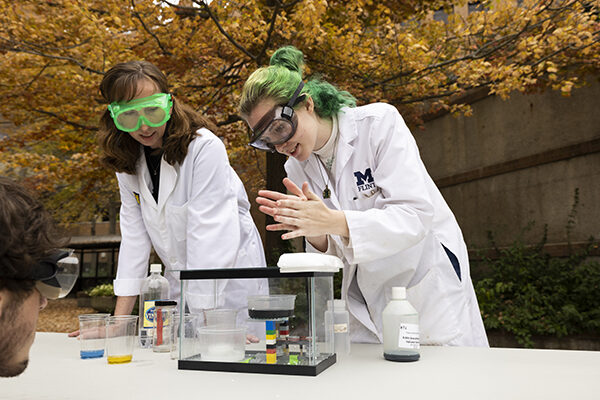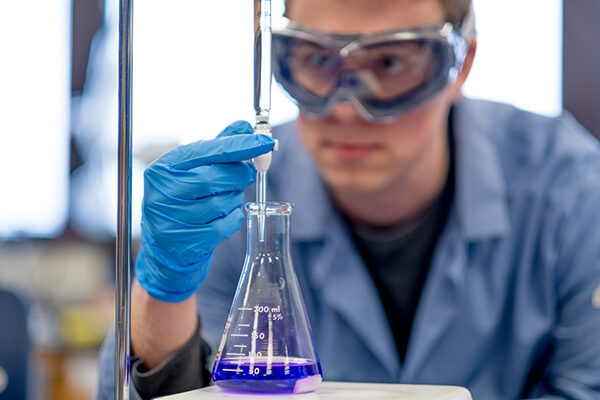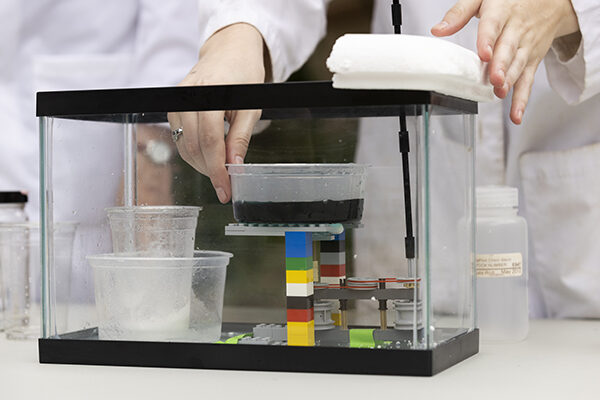
Associate Professor of Chemistry Jessica Tischler works with students Kelly Crowley and Ben Wood to conduct a demonstration in McKinnon Plaza.
Now in its fourth year, UM-Flint’s Green Chemistry program is helping students prepare for cutting-edge careers in rapidly changing industries like pharmaceutical and plastics manufacturing, hazardous waste management, and environmental remediation.
Nick Wills (Green Chemistry BS ’20) was one of the program’s first graduates. Now a chemistry Ph.D. student at Michigan State University, Wills is preparing for a career as a research scientist, exploring interests like small molecule synthesis for pharmaceuticals and polymers. He’s part of the next generation of chemists who are prepared to develop innovative, environmentally sound chemical solutions with the health and safety of the planet and its inhabitants in mind.
“I’m looking at not just what chemicals are in my lab space, but also where they’re coming from and where they’re going to end up as well,” Wills says. “It’s something I’ve taken with me going forward, and questioning if there are alternatives I can use as opposed to these reagents that are on the shelf.”

As demand grows for workers who can apply green chemistry principles in a variety of industries, Associate Professor of Chemistry Jessica Tischler poses a guiding question for her students: “How can we use chemistry as a tool to meet sustainability goals?” Her students are clear-eyed about the climate crisis, and they’re charting a path forward with creative problem-solving.
“This is a degree that will help you solve global challenges,” Tischler says.
Interdisciplinary approach fuels creative thinking
The Green Chemistry program includes courses from a variety of fields, like environmental science, political science, and economics, so students can develop the interdisciplinary lens they’ll need to responsibly shape the environmental, social, and economic impacts of chemistry.
Kelly Crowley (Green Chemistry BS ’23) says she’s enjoyed making connections across disciplines, especially between green chemistry and political science. “I found myself being able to say, for example, ‘these infrastructure changes can be justified using this data from green chemistry’ and being able to explain why that idea would work sustainably, environmentally and economically,” Crowley says. “I don’t do great with political science or English classes, but green chemistry has given me an opportunity to grow my strengths in those areas because I can take these concepts and really wrestle them around to fit within a green chemistry framework.”
Curiosity about social impact drives research experiences
For Wills, green chemistry has unlocked a new set of exciting and important challenges. Traditional chemistry training focuses primarily on the efficiency of a chemical reaction and its financial costs. “But with green chemistry,” Wills says, “now you have to not only keep those things in mind—because that’s important to a business—but also keep in mind the environmental impact, as well as the social impact.”
The social impact of a chemical reaction, and the products it helps create, can be difficult to parse. Wills explains, “If you’re going to be using, for example, some renewable resources such as corn feedstock, you have to keep in mind that you’re taking away that renewable resource to feed certain people.”
Crowley is exploring a topic that gets to the heart of questions about social impact as part of Dr. Tischler’s current research group. Their research project is looking at one specific Bisphenol A (BPA) alternative used in plastic storage containers, water bottles, and baby bottles.
Studies have shown that BPA can be harmful to the human body, and some countries have banned the chemical. While BPA is not commonly used in the US anymore, there is still a gap in knowledge about the alternative chemicals that are being used in everyday products.
“We’re taking one alternative and testing it in different solutions and different environmental factors like heat and time, and seeing how much of this alternative we’re actually going to be exposed to when using these products,” Crowley says. “A lot is known about BPA, and now we have all of these really great alternatives—we think—but we don’t know much about them. So we’re working on filling that gap in the knowledge.”
Research like this has far-reaching consequences for human health, and down the road, could even lead to legislation that better protects people and the environment from harmful chemicals.
“The laws and regulations around it just haven’t caught up with the science, unfortunately,” Crowley says. “It’s kind of a weird middle ground right now. Until we have enough solid data to make definitive decisions and actually put legislation into place to ban the use of one thing, or require the use of another thing, we’re kind of playing catch up.”
As an undergraduate, Wills also took advantage of opportunities to research in collaboration with faculty. He was able to present at an American Chemical Society conference, and he attended a Green Chemistry & Engineering conference. Looking back, he says the research he did as an undergraduate at UM-Flint was on par with his graduate-level research experience. “We were doing all of the experiments, and we were pushing for different ideas and/or different directions to take the project,” Wills says. “Research at UM-Flint has given me a lot of confidence and independence in the lab.”
A supportive scientific community strengthens learning experiences
In addition to rigorous undergraduate research experiences, UM-Flint’s award-winning Chemistry Club offers opportunities to take green chemistry into the community through science outreach programs. Chemistry Club students build community within the program, while also building professional skills through club activities. Crowley has served as the club’s demonstration coordinator, working with teachers to present science demonstrations to schools throughout the year.

“Going to schools is the most fulfilling part of the club—just being able to walk in there with a lab coat and all of these bins full of fun demonstrations and chemicals, and having these kids look up at you like you could show them the stars if they wanted you to,” Crowley says. “It’s definitely amazing because they get so excited and fascinated and kind of inspired by some of the things we talk about.”
Crowley got involved with the Chemistry Club right away, when Dr. Jessica Tischler and Lab Manager and Chemical Hygiene Officer Monique Wilhelm introduced her to some of the members during her campus tour. “Ever since then, I just never stopped going back to it,” Crowley says. “One of the best parts of my experience has been making these friendships with people.”
Both Crowley and Wills say the supportive environment created by professors has helped them excel and overcome obstacles.
“Initially, I thought I would just go there for classes and leave, but I found myself hanging around campus for almost the entire day because I had strong relationships with faculty and students,” Wills says. “If I could do it all over again, I definitely would, especially at UM-Flint, and especially with the faculty and my cohort. I still come and visit because it does feel like a second family there honestly. I definitely appreciate all they’ve done for me.”
Crowley echoes the importance of the support she’s received. “Everybody has always affirmed that, ‘you can do this, you’re smart enough, you’ve got this,’ and that they have your back and are ready in case you need some extra support,” Crowley says.
In 2017, UM-Flint became the 38th school in the country to sign Beyond Benign’s Green Chemistry Commitment, promising to prepare world-class chemists whose skills are aligned with the needs of the planet and its inhabitants in the 21st century. A year later, UM-Flint pioneered the state’s first undergraduate degree program in green chemistry. Now, as students like Wills have begun to complete their green chemistry degrees, the program is fulfilling its potential to help transform the future of sustainable chemistry through the vision, determination, and passion of our students.


